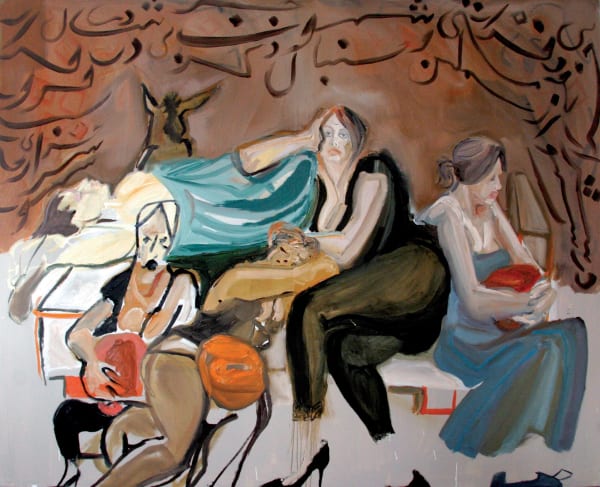The Donkey, The Pagan, The Bride: Rokni Haerizadeh
Rokni Haerizadeh paints with an extraordinary ability to immerse himself in the past - in myth and memory, literature and lore, whilst remaining firmly rooted in the popular culture and urban rhythm of the present. Born in Tehran in 1978, Haerizadeh has grown up with the Islamic Republic, and is as much an involuntary product of his times as he is a keen critic of his social environment. His work is largely an expression of the perennial discontent amongst Iranians that in recent years has manifested itself in a new generation of artists. In his playful yet carefully composed canvases, he constructs a refined review of Iranian mores and practices, often mischievously suggestive and always challenging to the status quo.
As Iranian artists before him, Haerizadeh reaches back into the rich literature of Persian history for potent allegory to address contemporary life. His new body of work demonstrates the diversity of his artistic endeavors and the universality of his appeal; several paintings are inspired from the fables of Shahnameh, the Persian Book of Kings, and the tales of the celebrated poet Rumi; others labour over the vibrant, unsettling scenes of modern urban life; a few works find their origins in the artist's personal reflections on life and art and identity, and are decidedly abstract in composition. In all these paintings, Haerizadeh scintillates with his highly personal and un- compromising pictorial narratives.
The series of five paintings entitled Masnavi Ma'navi: The Fifth Notebook is based on the eponymous tale by Rumi, from his celebrated book of poems. The theatrical relation between the Khatoon, her maid, and the donkey, embellished by the ornamental script, turn the absurd into the familiar. Haerizadeh cap- tures this decadent story in five charged canvases, and succeeds in at once revealing new dimensions of the lionized Rumi and elevating the perverse acts of the story through the integrity of his art.
-
 Rokni Haerizadeh, Khosrow and Shirin, 2008
Rokni Haerizadeh, Khosrow and Shirin, 2008 -
 Rokni Haerizadeh, Masnavi Ma'navi - The Fifth Notebook (02), 2007
Rokni Haerizadeh, Masnavi Ma'navi - The Fifth Notebook (02), 2007 -
 Rokni Haerizadeh, Masnavi Ma'navi - The Fifth Notebook (03), 2007
Rokni Haerizadeh, Masnavi Ma'navi - The Fifth Notebook (03), 2007 -
 Rokni Haerizadeh, Masnavi Ma'navi - The Fifth Notebook (04), 2007
Rokni Haerizadeh, Masnavi Ma'navi - The Fifth Notebook (04), 2007 -
 Rokni Haerizadeh, One Snowy Day, 2007
Rokni Haerizadeh, One Snowy Day, 2007 -
 Rokni Haerizadeh, Typical Iranian Wedding, 2007
Rokni Haerizadeh, Typical Iranian Wedding, 2007 -
 Rokni Haerizadeh, Tuesday Afternoon - Pahlavi Street, 2008
Rokni Haerizadeh, Tuesday Afternoon - Pahlavi Street, 2008 -
 Rokni Haerizadeh, The Anniversary of the Islamic Republic Revolution, 2007
Rokni Haerizadeh, The Anniversary of the Islamic Republic Revolution, 2007 -
 Rokni Haerizadeh, Pagans Dueling in the Steet, 2008
Rokni Haerizadeh, Pagans Dueling in the Steet, 2008









